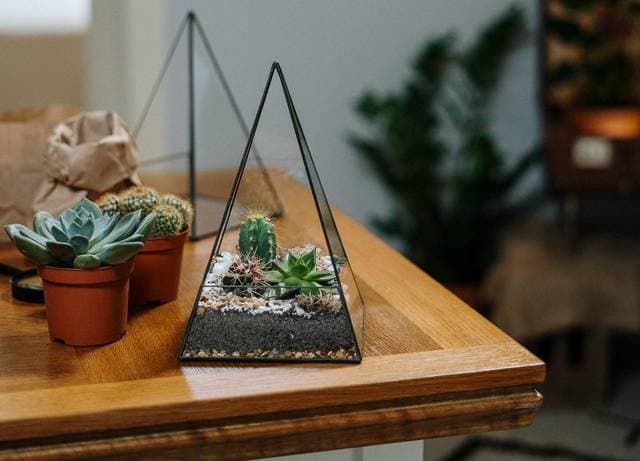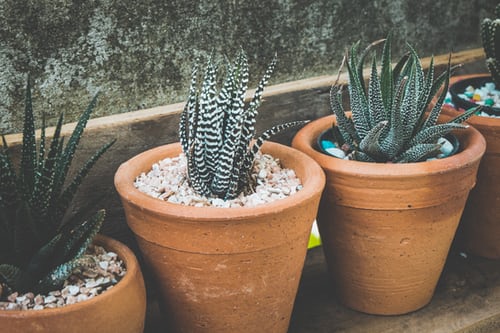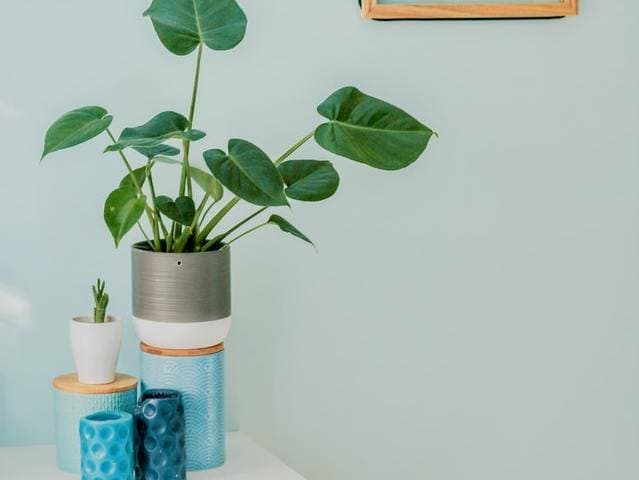Succulents love to thrive in drainage friendly potting mix & container. Yet, they can also survive vibrantly in pots with no drainage holes. In that case, you need to be extra wary regarding the watering practice and ensure that they have drainage friendly soil in place. So,
How to water succulents without drainage? Succulents are susceptible to damp soil & to root rot. So only water them when the potting soil feels dry. You can check the soil dampness using a moisture meter or by dipping your finger. Water the succulent with a sprinkler in a way so that the topsoil gets sufficiently wet. It should need watering once every 1-2 weeks.
Table of Contents
Do Succulents Need Drainage holes? Do you need drainage for succulents?
Importance of Drainage in succulents
Succulents are plants of drought-prone areas. Desert soil is mainly made up of sand which almost never retains water for long periods of time. Hence the succulents growing in these conditions are well acquainted with fast-draining soil and cannot retain moisture.
- So if you try to grow them in soil with an inadequate drainage system, it will lead to retention of moisture for a long time. In due course of time, this will lead to root rot which slowly will kill the plant.
Pros of having drainage holes
- They help in letting the excess water drip out of the pot and ensures that the soil dries up fast.
- Prevents the soil from being damp and hence protects the roots from root rot.
Cons of having drainage holes
- The region around the pot will get messy and watery every time you water the succulent. This is especially a problem if you are growing your succulents indoor. However, this has got an easy fix. You can place the pot over a tray and every time you water the plant, you can just get rid of the excess water from the tray and place it back again.
What’s the main problem Succulents can face without drainage?
- The soil will remain wet for days after you water them.
- The moisture content will be high especially around the base of the roots.
- Succulents dislike wet waterlogged conditions and in due course of time, this will cause root rot.
- Root rot slowly spreads to other parts of the plant through the stem and the bottom leaves will get affected at first. After that, the whole plant will end up dying.
How to make Drainage holes at Home?
Well, the best way to make drainage holes in your pots is to use a driller. If you don’t have a driller, you need to ask yourself which one will be more profitable for you…
- Buying a new driller or buying a new pot for your succulent that has got drainage holes at the bottom. Well if you decide on the former then it won’t go in vain cause a driller is always handy equipment to keep at home and you will come up with various uses from time to time.
If you just wanna save all the hassle then you can just buy succulent drainage friendly pots with drainage holes.
How to Plant in Pots without Drainage Holes?
Well if you are wondering that can succulents survive without drainage holes, then the answer is yes they sure can.
However, if you are a beginner succulent grower then you should stick with using pots with drainage holes.
- Its because if you grow your succulents in pots without holes, you need to be extremely careful regarding the watering.
- You need to know exactly when to water them and not end up overwatering them.
- Most succulents without drainage die from overwatering. In fact, underwatering won’t affect these plants that brutally, the way overwatering will.
So if you wanna grow succulents without drainage then 4 elements become crucial:
- Your watering schedule
- Watering Technique
- The soil mix
- The Pot
Also Read: How do Cactus store Water?
Ideal Watering Schedule for Succulents with no Drainage
This depends on:
- The kind of climate you generally have & the time of the year it is.
- Succulent type and its size.
- The size of the pot.
If the humidity is high in the air then you need to water less frequently than if you live in a place with low humidity. Also, succulents will need to be less watered during their dormant season which is mainly in the winter.
- Succulents are not tropical plants and you MUST NOT WATER THEM REGULARLY.
You should only water them when the soil is completely dry. The soil needs to be dry both in the upper layer and in the bottom layer.
What is the best way to find out if your soil is dry or not?
- Few days after watering, use a moisture meter and dip it deep into the soil and measure the soil moisture to determine if the soil is dry or damp.
If it’s damp then you need to what for a few more days to water it. Once you get the hang of how long it usually takes for that succulent to dry up, you can stick to that watering schedule. However, keep on doing this exercise of checking the moisture from time to time to be sure.
- Alternatively, you can also use your finger to measure the dampness but using a moisture meter is a more sure-fire way.
Along with all these, you should also keep your succulent near a window or balcony where it will receive just enough of indirect sunlight throughout.
Also Read: Do Succulents Need Sun to Grow?
What is the best Soil mixture to use for growing Succulents?
Ideally, you should try to use a cactus soil mix for the soil.
- You can also prepare your own potting mix at home. An ideal soil mixture suited for pots without drainage must have 2/3rd of inorganic matter and 1/3rd of organic matter. For the organic part, never use garden soil, buy the potting soil from the nearby store or online.
As for the inorganic portion try to include pebbles, volcanic rocks, pumice, sand, etc. This will promote better drainage as the water will move out of the soil quickly and onto the rocks, allowing the roots to thrive in a moisture-free environment.
- Using this mixture will also allow proper aeration which is also essential for the growth of the succulents.
- Be wary of the pot size as the mixture amount you will need will depend on that. Make sure that all these elements are properly mixed.
Bonus:
You can also consider creating an extra layer of activated charcoal at the very bottom as it absorbs the excess water and has antimicrobial properties that can prevent fungal or bacterial infections.
However, this option is not a must and you should only do it if you have a sufficiently large pot and have a little bit of experience handling preparation soil mixtures.
Also Read: Is Coffee Ground Good for Succulents?
How to further ensure that the Succulent won’t face any problem with no Drainage holes?
- Stick to a proper watering schedule (Always remember less is beneficial for the succulents in case of watering)
- Have the right kind of soil mixture
- Have a pot which is compact
- Place your succulent in a place where it will receive filtered sunlight
You can also use the concept double potting you can use two pots to grow the succulent:
- The large pot will have gravels at the bottom and you can place the succulent in the smaller pot with the proper soil mixture and you can make some holes in its bottom and place it over the gravels of the larger pot.
- In this way, you can easily combat the issue of water leakage below the pot.
How to water plants without drainage holes?
If you don’t have any drainage holes then consider watering the plants once every 7 to 14 days and always check the soil moisture content before watering. (Again this varies as per the season)
- You need to be smart while watering causes the excess water have no drainage to leak out.
- Use a succulent spray bottle to water the plant. They will provide you with better control. Always target the stem base and the soil while watering and not the upper parts as water will get absorbed through the roots only.
Also, wait for a few days before you start watering your plant after potting it.
And start watering with low amounts of water, lower than your succulent will normally need. Say about 1/3rd cup of water and see how everything goes and adjust hereon. Never water the potting soil directly from a cup, use the sprinkler.
Also, Read: 5 Gorgeous Succulents that looks like Corals
When should succulents be repotted?
- When you feel that the succulent is showing signs of root rot
- When you feel the soil you previously used to pot the plant is not suitable enough
- You want to multiply the number of succulents you have i.e. want to do propagation
- Even with no issues, you should repot your succulents every 2 to 3 years for better growth.
If you see your succulent showing any signs of rot or other discomforts, you should propagate them.
You can try to pluck the main plant, cut off the affected areas, keeping it for healing under shade for a few days, and then put it back in a new pot with new cactus soil mixture. Wait for a few more days before you water.
FAQ
What should you do if you overwater your plant accidentally someday?
No need to worry, just tilt the pot and let the excess water flow out. Keep a stronghold over the plant during this so that it does not get affected. Wait for a few more days than you normally would before you water it again.
How can you tell if a succulent needs water?
- By looking and measuring the soil moisture
- By giving an overall look on the plant and seeing if it shows any sign of dryness or not
- Leaves are shriveling or not
- You need to keep an eye on the leaves, they feel soft and dry or not.
- Whether the vibrancy color of the plant is intact or not
Should I put rocks in the bottom of my planter?
You should only put rocks in the bottom of the planter in case it does not have any drainage holes. In this scenario, the rocks will act as an extra layer which will help in better drainage of water from the soil. However, in case the pots have drainage holes, putting rocks at the bottom will block those holes and hamper the drainage system.
Conclusion
Succulents can thrive in pots without drainage holes if certain precautions are taken. The end goal is to not make the plant sit on moist soil. To counter this,
- Water the succulent little bit less than you would normally would, water just enough to soak the soil.
- Provide a suitable drainage friendly soil
- Place the pot in a place that gets sufficient sunlight
- Give an extra layering of pebbles and other rocks in the bottom of the planter
Also Read:
- How Long can Succulents Go Without Water? (Ultimate Study)
- Can you plant Succulents in Mason jars or Glass Containers?
If you liked this post, then leave a comment below to let me know!
Cheers



